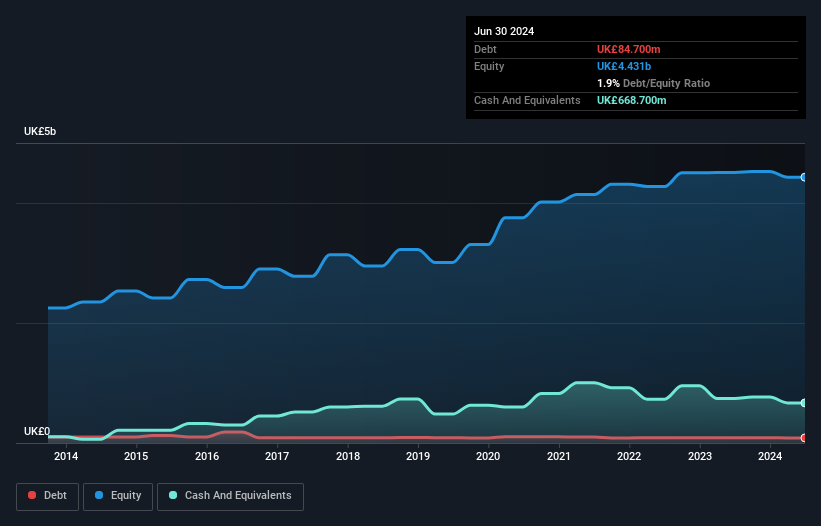- United Kingdom
- /
- Consumer Durables
- /
- LSE:TW.
Here's Why Taylor Wimpey (LON:TW.) Can Manage Its Debt Responsibly

Legendary fund manager Li Lu (who Charlie Munger backed) once said, 'The biggest investment risk is not the volatility of prices, but whether you will suffer a permanent loss of capital.' So it seems the smart money knows that debt - which is usually involved in bankruptcies - is a very important factor, when you assess how risky a company is. We note that Taylor Wimpey plc (LON:TW.) does have debt on its balance sheet. But the real question is whether this debt is making the company risky.
When Is Debt A Problem?
Generally speaking, debt only becomes a real problem when a company can't easily pay it off, either by raising capital or with its own cash flow. Part and parcel of capitalism is the process of 'creative destruction' where failed businesses are mercilessly liquidated by their bankers. While that is not too common, we often do see indebted companies permanently diluting shareholders because lenders force them to raise capital at a distressed price. Of course, the upside of debt is that it often represents cheap capital, especially when it replaces dilution in a company with the ability to reinvest at high rates of return. When we think about a company's use of debt, we first look at cash and debt together.
See our latest analysis for Taylor Wimpey
What Is Taylor Wimpey's Debt?
As you can see below, Taylor Wimpey had UK£84.7m of debt, at June 2024, which is about the same as the year before. You can click the chart for greater detail. However, it does have UK£668.7m in cash offsetting this, leading to net cash of UK£584.0m.

How Healthy Is Taylor Wimpey's Balance Sheet?
According to the last reported balance sheet, Taylor Wimpey had liabilities of UK£1.20b due within 12 months, and liabilities of UK£652.1m due beyond 12 months. On the other hand, it had cash of UK£668.7m and UK£167.0m worth of receivables due within a year. So its liabilities total UK£1.01b more than the combination of its cash and short-term receivables.
Of course, Taylor Wimpey has a market capitalization of UK£5.85b, so these liabilities are probably manageable. Having said that, it's clear that we should continue to monitor its balance sheet, lest it change for the worse. While it does have liabilities worth noting, Taylor Wimpey also has more cash than debt, so we're pretty confident it can manage its debt safely.
The modesty of its debt load may become crucial for Taylor Wimpey if management cannot prevent a repeat of the 44% cut to EBIT over the last year. Falling earnings (if the trend continues) could eventually make even modest debt quite risky. There's no doubt that we learn most about debt from the balance sheet. But ultimately the future profitability of the business will decide if Taylor Wimpey can strengthen its balance sheet over time. So if you want to see what the professionals think, you might find this free report on analyst profit forecasts to be interesting.
Finally, a business needs free cash flow to pay off debt; accounting profits just don't cut it. While Taylor Wimpey has net cash on its balance sheet, it's still worth taking a look at its ability to convert earnings before interest and tax (EBIT) to free cash flow, to help us understand how quickly it is building (or eroding) that cash balance. Looking at the most recent three years, Taylor Wimpey recorded free cash flow of 37% of its EBIT, which is weaker than we'd expect. That weak cash conversion makes it more difficult to handle indebtedness.
Summing Up
While Taylor Wimpey does have more liabilities than liquid assets, it also has net cash of UK£584.0m. So we are not troubled with Taylor Wimpey's debt use. The balance sheet is clearly the area to focus on when you are analysing debt. But ultimately, every company can contain risks that exist outside of the balance sheet. Case in point: We've spotted 3 warning signs for Taylor Wimpey you should be aware of, and 1 of them doesn't sit too well with us.
If you're interested in investing in businesses that can grow profits without the burden of debt, then check out this free list of growing businesses that have net cash on the balance sheet.
Valuation is complex, but we're here to simplify it.
Discover if Taylor Wimpey might be undervalued or overvalued with our detailed analysis, featuring fair value estimates, potential risks, dividends, insider trades, and its financial condition.
Access Free AnalysisHave feedback on this article? Concerned about the content? Get in touch with us directly. Alternatively, email editorial-team (at) simplywallst.com.
This article by Simply Wall St is general in nature. We provide commentary based on historical data and analyst forecasts only using an unbiased methodology and our articles are not intended to be financial advice. It does not constitute a recommendation to buy or sell any stock, and does not take account of your objectives, or your financial situation. We aim to bring you long-term focused analysis driven by fundamental data. Note that our analysis may not factor in the latest price-sensitive company announcements or qualitative material. Simply Wall St has no position in any stocks mentioned.
About LSE:TW.
Taylor Wimpey
Operates as a homebuilder company in the United Kingdom and Spain.
Flawless balance sheet and undervalued.
Similar Companies
Market Insights
Community Narratives



